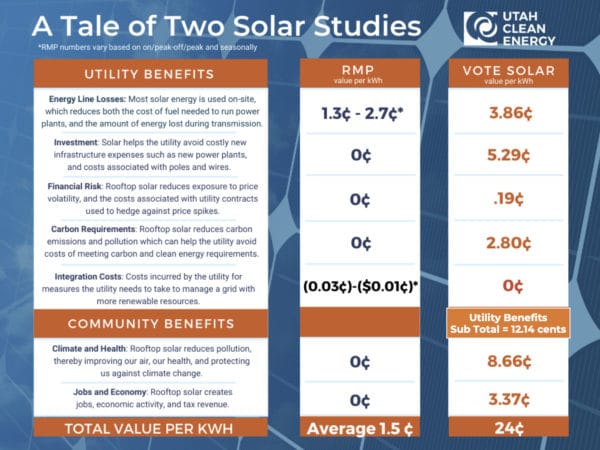The Utah Public Service Commission (PSC) made a decision on the value of the rooftop solar in the state, lowering the current export rate from the average of 9.2¢/kWh, instead to summer and winter rates of 5.969 cents/kWh and 5.639 cents/kWh respectively.
At the start of this hearing, utility Rocky Mountain Power (RMP) was proposing that it pay an average price of 1.5¢/kWh for new customers starting in 2021, an 84% reduction. RMP was also asking for a one-time $150 application fee and a $160 customer generation meter fee.
Vote Solar argued that the actual value of solar is 22.6¢/kWh, but had called on regulators to abandon this rate structure entirely and move back to net metering.
Here’s the wording and the math from today’s PSC judgment.
We approve an export credit rate for customer generation of 5.969 cents/kWh in summer rates and 5.639 cents/kWh in winter rates. These rates represent an avoided energy component of 2.439 cents/kWh in summer rates (June through September) and 2.109 cents/kWh in winter rates (October through May), plus total avoided generation, transmission, and distribution capacity costs of 3.53 cents/kWh.
The ruling declined to approve RMP’s proposed application fee or metering fee.
Since the first net metering law was passed in Minnesota in 1983, grid-tied customers exporting power to the grid expect to be compensated “at the average retail utility energy rate.” And since that day 37 years ago, utilities across the land have challenged the value that distributed rooftop solar provides to the grid.
RMP math versus Vote Solar math
Neither party got what they wanted from this PSC decision, but the immediate impact will be felt by potential solar customers and Utah’s solar industry.
Grace Olscamp of the Healthy Environment Alliance of Utah (HEAL) said that her organization was “disappointed” over the decision — and that the 9.2¢/kWh rate “was already a low export credit” — with the PSC bowing to industry “despite other expert input that found the export credit rate should be raised.”
Olscamp said, “The Utah solar industry has already lost jobs to Covid” and this eliminates forecasting and “adds so much uncertainty.” She added that many Utah solar companies have already seen a drop in installs in response to the potential rate change. HEAL Utah’s Executive Director Scott Williams said. “Deliberately deciding not to value the environmental, public health, and economic development implications associated with rooftop solar is a severe disservice to the customers the PSC is meant to protect.”
Kate Bowman at Utah Clean Energy, contended during a webinar earlier this month that RMP’s assessment of solar’s value was narrow and based on fuel costs.She said a rate reduction would “sends a signal to customers that their investment is worthless” with no savings over 25 years. In that same webinar, Joshua Neves, general counsel at Utah’s Blue Raven Solar, said that Blue Raven Solar was forced to shift many of its operations to others states as a result of the last rate reduction in 2017.
New rooftop solar installations in Utah went from 4,140 in 2016 to 12,408 in 2017 before falling to 3,540 last year, in response to cutting the state’s net metering program, according to the Utah Solar Energy Association. There are approximately 7,000 people employed in the solar industry in Utah today.
Rocky Mountain Power’s proposal was based on its own survey data and the rapidly evolving economics of solar technology, according to utility spokesman Spencer Hall, quoted in the Salt Lake Tribune.
Utah Clean Energy claims that Rocky Mountain Power “only considers a few of the benefits of solar energy.” Vote Solar calculated the value of solar to be 24 cents per kilowatt-hour – more than double the current rate of 9.2 cents. Here’s a comparison of the calculations.









Using up your own energy first so the utility gets NONE. If your energy is only worth 2 cent to them but 12 cents or more to you, then use it up. Even if you do not have batteries, you can read your meter daily and if you have excess, run the electric heater a little longer or heat more rooms with electric heat or in the summer, run a window air conditioner or two so that every day at 4:00 PM, when you read your meter, it reads the same numbers or close to it. The more you use your own electricity, the lower your natural gas or fuel oil bill will be.. If the utility wants a $50.00 a month connection charge, then take part of your home “OFF GRID” with batteries and a few off grid inverters and hook them to loads that always run like refrigerators, lights and heating or air conditioning mostly durring the day when you have both solar and battery power to draw from then only buy your nightime power from the utility. Your power is your power..